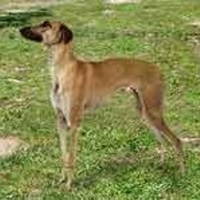 |
Banjara Greyhound |
|
He is not recognized by the F.C.I. |
Origin |
India | |
Translation |
Francis Vandersteen |
| The Banjara Greyhound is one of the lesser-known breeds of dog and was developed by the gypsy group from which it takes its name. The Banjara are the largest gypsy group in India. The word "banjara" comes from "bajika", meaning "trade", and "banji", which is a peddler's wrapper. Banjara is distributed in over 50% of Indian districts. While Banjara were once nomads who herded cattle and transported goods, most are now engaged in cattle breeding or grain cultivation. Others trade in salt and other products. Women wear beautifully embroidered clothes and are fond of ornate jewelry incorporating shiny discs and beading. The dogs that accompanied the Banjara from place to place throughout rural India were indispensable to the tribes. They had to hunt game, guard camps and help control and move stocks. The Banjara Greyhound is also known simply as the Banjara or the Vanjari. It has rarely been seen outside India, but the Continental Kennel Club now has a breed description. The Banjara is thought to have originated from local dogs crossed with Salukis. The Banjara is a hunting dog (hunting by sight) and is fast and strong. Prey such as gazelles were hunted for meat. When he's close enough to attack his quarry, he instinctively reaches back and pulls the animal down. When hunting, it has a deep barking voice and is a fearless attacker. In appearance, the Banjara has the shape of a regular sighthound with long, slender lines and a long, narrow muzzle. The head, too, is long and narrow and held high. The dark eyes are almond-shaped. The ears lie flat on the head and are well feathered, as are the feet. The chest is deep and the ribs well sprung. The long neck is strong and well arched. Banjara are 68.5 to 73.5 centimeters tall and weigh 22.5 to 29.5 kilos. The coat is rough but silky to the touch. Banjaras are black with blue or gray mottling. The front legs are straight and strong, and the paws are of good size. The tail is well feathered and slightly curved. It is agile and fast with free movement and great stamina. As you'd expect, the Banjara is energetic and lively. They are working dogs, and although relaxed and friendly when not working, they are focused and determined when hunting. Lifespan is around 13 to 14 years. A very old breed, the relative isolation of the gypsies has ensured its survival as a pure breed. However, with the continuing integration of gypsies into mainstream society, the breed is at risk of uncontrolled cross-breeding. |






 English (United Kingdom)
English (United Kingdom)